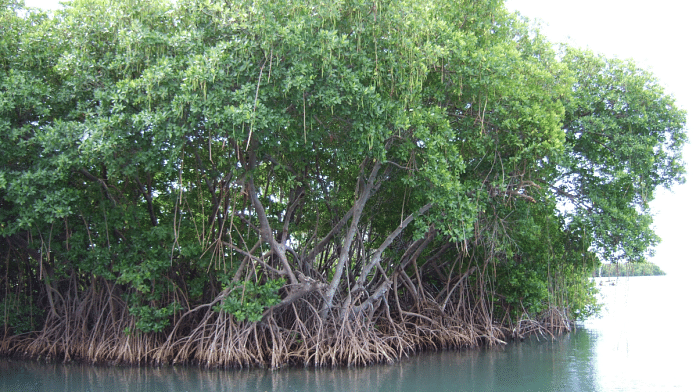New Delhi: A team of scientists from Universidad EAFIT in Colombia, the Smithsonian Tropical Research Institute in Panama and Boise State University in the US have discovered over 120 fossilised mangrove wood specimens that are estimated to be over 22 million years old, on Barro Colorado Island in Panama.
The study, which is to be published in the March 2024 edition of the Palaeogeography, Palaeoclimatology, Palaeoecology journal, said that the petrified mangroves were buried after a volcanic eruption sometime during the Early Miocene Period (23-25 million years ago). A version of the study was made available online earlier this month.
According to researchers, the lava helped conserve the trees and slowed down decomposition, thus allowing scientists to study the remains of the wood of the trees. Analysis of the wood remains reveals that these mangrove trees grew almost 40 meters (or 131 feet) in height — more than present-day mangrove forests, which typically grow up to 6-8 metres. Read more here
Also Read: One giant leap for computing? Scientists develop 1st functional semiconductor made from graphene
Oldest recorded Turner syndrome case in prehistoric human DNA
DNA analysis of prehistoric humans has led researchers to discover the oldest recorded case of Turner syndrome — a female-specific condition that leads to short height and fertility problems due to one missing X chromosome.
According to a new research paper published in Communications Biology journal on 11 January, DNA from skeletal remains of prehistoric humans from around 2,500 years ago revealed that one of them suffered from Turner syndrome. The analysis also led to more interesting discoveries, such as a male with an extra Y chromosome, known to cause Jacob’s syndrome, a rare condition characterised by relatively tall stature and known to affect males.
The research, conducted by London’s Francis Crick Institute, focussed on sex-chromosome-related disorders in prehistoric DNAs. Researchers say the analysis is a precursor to discovering how societies back then treated humans with such disorders. Read more here.
Dopamine affects brain when you meet your partner
What happens in your brain when you meet the person you love? Researchers from the University of Colorado have set out to discover just that.
In a paper published on 12 January in Current Biology, researchers studied prairie voles — a kind of rodent that is known for forming lifelong bonds with partners. To uncover what went on in their brains and how dopamine plays a role in bonds between partners, researchers used neuroimaging technology. The study found that dopamine played an important role while the voles were seeking their partners, and also was a ‘reward’ hormone when they found their partner. It also found that the amount of dopamine detected while meeting one’s partner was more than when meeting another vole.
The research has deeper implications for understanding hormonal behaviour during social interactions. Read more here.
Bats leapfrog over others when they return from a hunt
Bats leapfrog over each other when they return from a hunt to maximise hunting time and stay safe from predators, a new study has found.
According to a study published in the Bulletin of Mathematical Biology on 10 January, a team of researchers team from Cardiff University and the University of Sussex developed a mathematical model to analyse radio-tracking data collected over 14 nights.
The study was aimed at understanding bat movements after leaving their roosts to hunt. Researchers discovered bats disperse to cover a wide radius while hunting and follow a leapfrog pattern when they return. Read more here.
(Edited by Uttara Ramaswamy)
Also Read: How do jellyfish regrow their limbs in 3 days? Tokyo scientists have an answer



